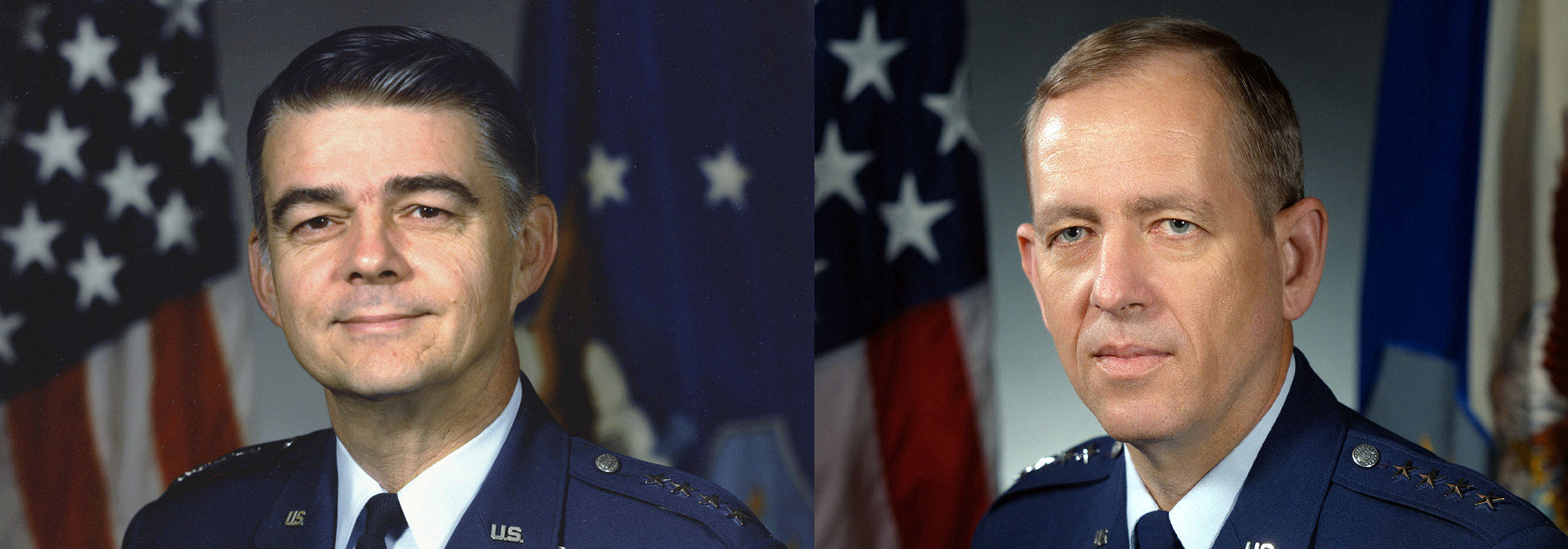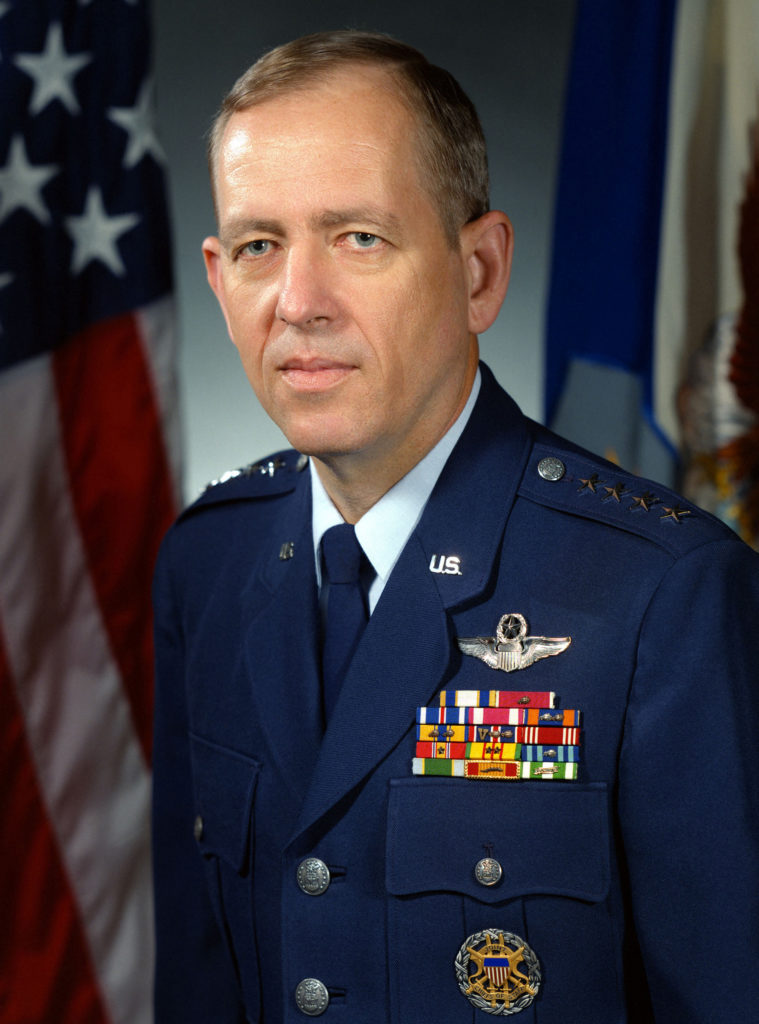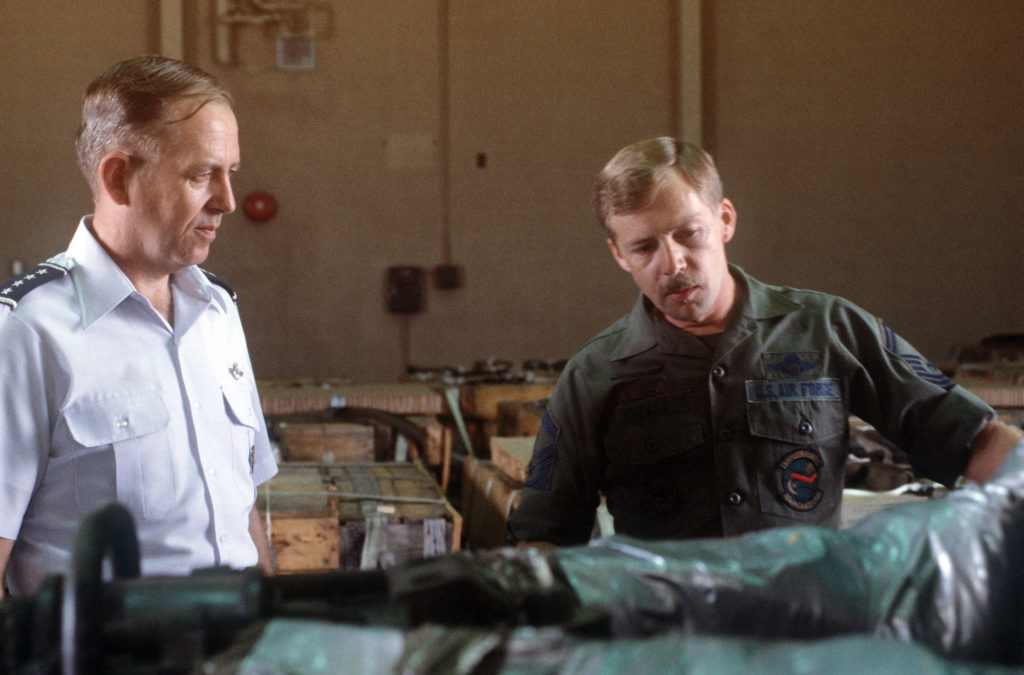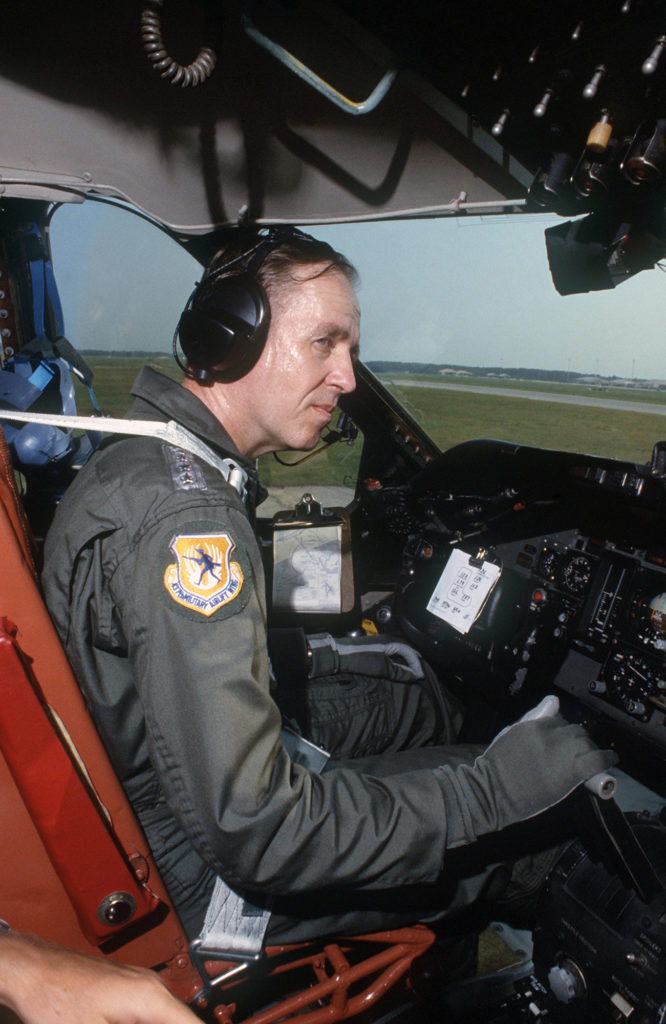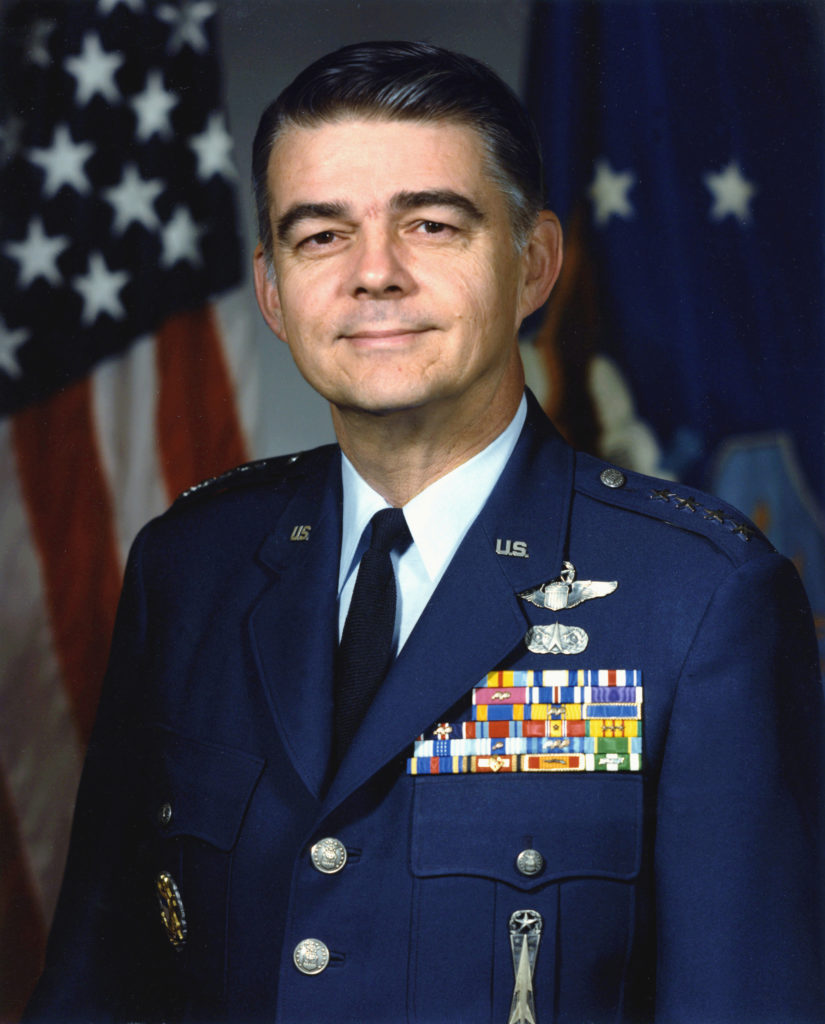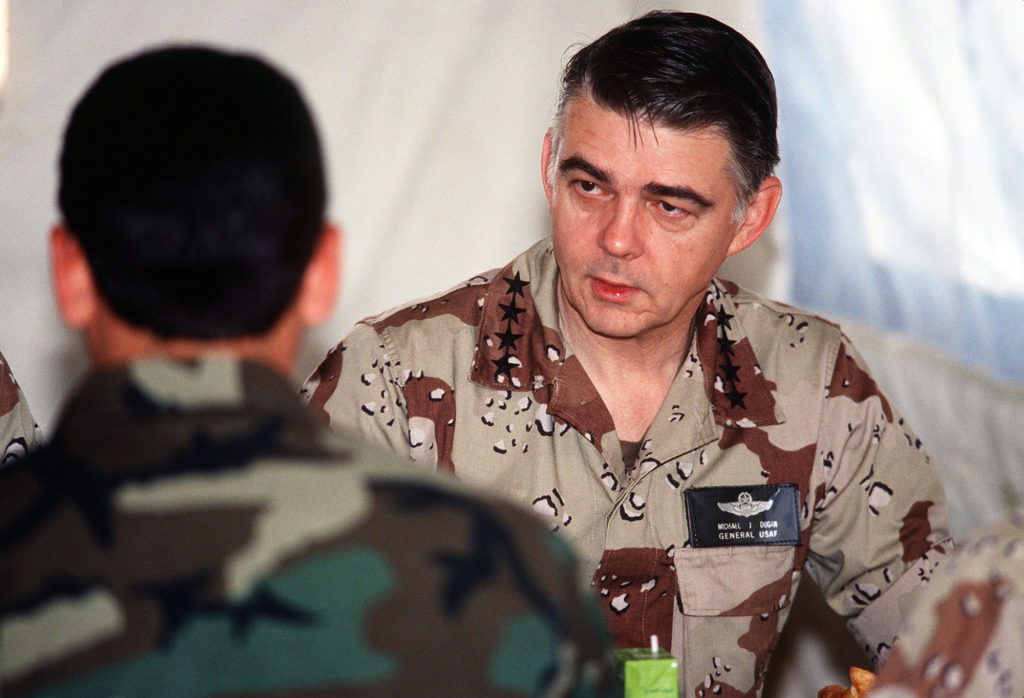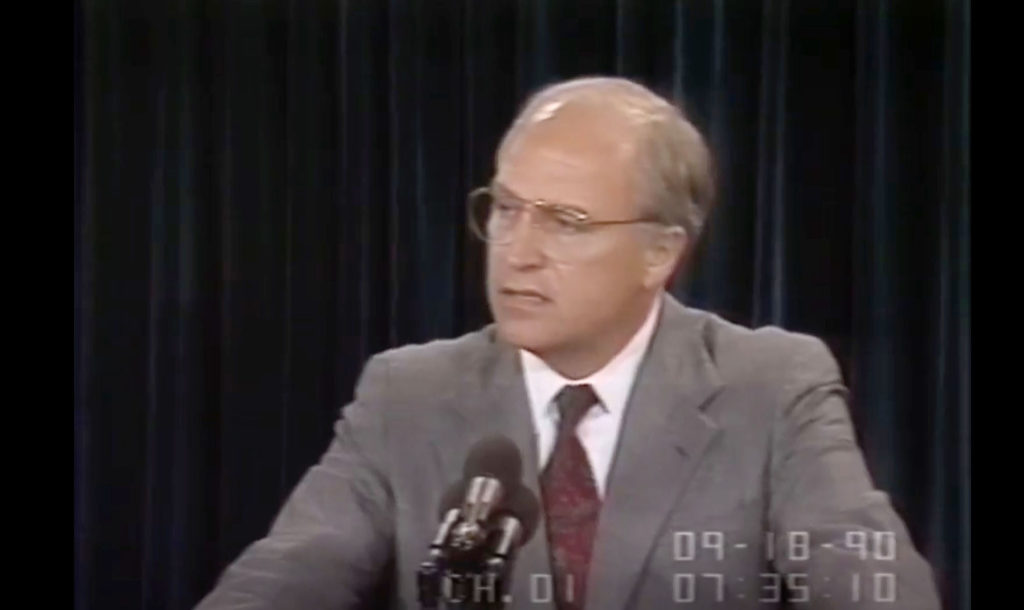When I embarked on this series of interviews and articles, I imagined writing a single package of short articles in a single issue of the Magazine. But once I had begun the process, it was obvious that would be impossible. Each interview ran more than an hour, and some ran two or more. The stories and insights built on each other, like pieces of a puzzle, and the whole—10 former Air Chiefs whose collective tenure ran from 1987 through 2020—matched up almost exactly with my own career as a military journalist. History I had lived through and helped tell now came into focus in different shades of blue. This final installment goes back to the beginning: Two Chiefs I hadn’t originally expected to interview, Gens. Larry D. Welch and Michael J. Dugan.
Welch is a key figure, the last of the Cold War Chiefs. Goldwater-Nichols passed months after he took office, as Welch noted in our interview, the changes wrought by Goldwater-Nichols were not immediate. Dugan was the true transitional Chief, the first Chief to come to office in the post-Goldwater-Nichols era, and the first to serve in the modern media era, at the dawn of the perpetual, 24-hour news cycle. The confluence of these two were, in fact, the twin factors that led to his untimely relief.
In his column in the Washington Post days after that relief, Richard Cohen wrote that “Dugan got what he deserved.” With the benefit of hindsight, that seems unfair. Dugan spoke to reporters on the record and with apparent clarity. While unguarded, he violated no laws, divulged no national secrets, was not insubordinate. Dugan spoke as an Airman and failed to make clear that in espousing Air Force doctrine, he did not and could not speak for the war planners, the Joint Chiefs, the Secretary or the President. His abrupt departure changed the course of Air Force history.
It seems oddly fitting, therefore, to conclude the series there and to ponder, after reading these last two installments, a simple but provocative question. How might the Air Force have evolved had then-Defense Secretary Richard B. Cheney chosen a different course, had he opted for humility, as opposed to humiliation; had he asked Dugan to apologize to his fellow Joint Chiefs for his carelessness and cavalier talk. Cheney’s decision was decisive and Operations Desert Shield and Desert Storm were a great success. Yet the wound inflicted on the Air Force that September day had consequences far beyond that war, consequences that lasted well into the decades that followed.
Larry D. Welch never planned to stay in the Air Force, let alone become Chief of Staff. Having enlisted in 1951, Welch was a one-striper, temporarily marching new recruits around Lackland Air Force Base, Texas, when he led a group to a briefing about the aviation cadet program. When it was over, interested recruits were asked to put a card in the basket.
Welch, who was standing in the back of the room waiting to escort the recruits to their next stop, put his name on a card and dropped it in the basket. Soon after, he was summoned to a captain’s office; the captain praised his scores and sent him for further testing. “At the end of that, I had two choices,” Welch said. “I could go into a program that would make me a second lieutenant and a pilot, or a program that would make me an Airman First Class electronics technician.”
It wasn’t a hard decision.
Time after time over the course of the next three-plus decades, Welch came to a fork in the road and found another opportunity waiting for him. He served in fighter units in Europe, the continental United States and Alaska, deployed to Vietnam, and held a series of leadership posts at Tactical Air Command. He shepherded President Ronald Reagan’s strategic programs through the budget and approval process—the B-1 and B-2 bomber programs, the M-X intercontinental ballistic missile, and two cruise missile programs—as deputy chief of staff for programs and resources, and in July 1984 he was promoted to Vice Chief of Staff, replacing Gen. Jerome O’Malley.
Welch hoped to finish his career leading Strategic Air Command, and Air Force Chief Gen. Charles Gabriel already envisioned his succession plan. “I don’t think I’m breaking any confidence here,” Welch said. “The plan was that Jerry O’Malley was supposed to be Charlie Gabriel’s replacement, but Jerry didn’t have any real fighter time. So Jerry would go to command [Tactical Air Command] for a couple of years, I would take SAC for a couple of years, and then when Jerry became Chief, I would go to TAC.”
Tragically, however, O’Malley died on April 20, 1985. The CT-39 Sabreliner executive jet he had taken to a Boy Scout event landed flawlessly that day in Wilkes-Barre, Pa., but when the pilot applied his breaks, nothing happened. A hydraulic valve in the landing gear had broken, and the airplane overshot the end of the runway, and then down a 110-foot embankment, where it burst into flames—killing everyone on board.
“That threw everything up in the air,” Welch said. “Jerry O’Malley would have been a great Chief. I’m sorry that he didn’t get to do that.”
Welch was an obvious candidate to replace O’Malley at TAC, but the nuclear enterprise was a primary focus for President Reagan and Secretary of Defense Caspar “Cap” Weinberger. The Air Force put forward one three-star after another for promotion to four-stars and command of SAC. “The SecDef turned down all three nominees,” Welch recalled. “Secretary Weinberger was having no part of that. He wanted someone he knew, and that someone was me.”
So Welch got to command SAC, the job he’d envisioned as his last in uniform, what he calls now “the pinnacle of my career.” And not many months later, Secretary of the Air Force Donald Rice came out to visit him, asking questions that in retrospect were about the Chief’s job. “It was certainly clear to everyone that I was sure as hell not campaigning to be Chief,” Welch said. But not long after, Rice let him know he was putting Welch’s name forward to succeed Gabriel.
“Being an Airman is not just about operating in the domain. The Army, Navy and Marine Corps combined operate in the domain more than we do. They have 8,500 aircraft, we have 5,300. … Years ago, I was the vice chair on a congressionally directed study on roles and missions, and a serious question was asked: Did we really need an independent Air Force? Would we have done just as well to stay in the Army? The answer from the study group, which is very broad, a lot more than just Air Force, was: ‘That would have been a disaster.’ If you didn’t have a service, a professional corps that was focused on operating in, through, and from that domain, we never would have developed anything like the range of capabilities that now are available—not just to the Air Force—but to the other services, operating in the domain where we provide the most expertise. That’s what it means to be an Airman.”
GOLDWATER-NICHOLS
Welch became Chief July 1, 1986. Almost exactly three months later, Congress passed the Goldwater-Nichols Department of Defense Reorganization Act on Oct. 4, a revolutionary and sweeping measure that reformed the leadership structure of the armed forces and changed the future of career and assignment policy. The new law elevated the Chairman of the Joint Chiefs and redefined the operational chain of command, which now flowed from the President, through the Secretary, and down to the unified Combatant Commands—bypassing the service chiefs. Air Force and Army Chiefs of Staff, the Chief of Naval Operations, and the Marine Corps Commandant now became responsible solely for manning, training, and equipping the force. They were no longer in the business of executing war plans.
But change came slowly.
“Goldwater-Nichols didn’t change much of anything for a significant period of time,” Welch recalled. “So during the four years, … the principal effect was that they added authority to the combatant commanders. It didn’t relieve the service chiefs of any responsibility for that period of time. Well, just for example: In order to respond to Goldwater-Nichols, the combatant commanders were invited to the big high-level reviews. There used to be only the secretaries and some of the assistant secretaries and service chiefs. [Now the combatant commanders] attended those meetings—they were invited—[but] they didn’t say anything. They just observed. Because they were supposed to have a new role, but they were totally unprepared to fulfill it.”
Welch said that three of the four service chiefs were very supportive of the new law, and that in his view there was only one major flaw in the legislation: its requirements for joint tours. “It was unreasonable and unexecutable,” he says now. “But we worked around that.”
Changing the culture across the services, however, was not automatic. When the commander of the U.S. Navy’s Pacific Fleet, Adm. James A. “Ace” Lyons Jr. declined to follow the orders of his regional combatant commander, U.S. Pacific Command’s Adm. Ronald J. Hays, Lyons was forced to resign. “The issue was over sending PACFLEET ships into CENTCOM’s area of operations,” Welch said. It was the summer of 1987, and “PACFLEET absolutely defied it. And in order to correct that, the Joint Chiefs went to the Secretary of Defense, who went to the President.” Lyons’ career ended with his retirement that Oct. 1.
“I don’t think that ever would have happened without Goldwater-Nichols,” Welch said. “That was an interesting lesson to people, that—Hey! The authority of a combatant commander is a serious thing, and you had better pay attention to it.”
The impact on the service chiefs and how they operated as the Joint Chiefs of Staff was greater. “The first real effect of Goldwater-Nichols was a sort of a too-rapid move to the Joint Staff,” Welch said. “The relationship to the Joint Staff changed faster and more dramatically. In the first place, the Joint Staff began to exercise a lot more authority on service programs. And that caused a lot of angst, and it didn’t work very well.”
Suddenly more officers from other services, with less experience, were asking questions and getting involved in programs that they didn’t necessarily understand. The balance of power was now shifting, moving away from the service chiefs and their domain expertise to a joint staff whose priorities were not necessarily the same. This involvement only grew over time.
“When I was a service chief … maybe 5 percent of our program had issues with … the highest-level meeting, with the SECDEF and the undersecretaries,” Welch said. Today, however, “a service chief would probably tell you 50 percent of his program is seriously affected by the Joint Staff and OSD [Office of the Secretary of Defense]. I don’t know if that’s good or bad,” Welch said, “I just know that the service chief is the leading expert in that domain, and the service chief’s staffs are the real experts in that domain. … And I think that remains a problem.”
Welch says the net effect of these extra layers of review has not been effectiveness, but inefficiency. He notes that in his day, “our criteria was five to seven years to field an increment of new capability.” There was logic to that, because “Five to seven years was about as far as we could see geopolitically, it was certainly as far as we could see technologically, and it was probably as far as we could see in terms of tactics and strategy. Well, now the average time has doubled, while the horizons have shortened.”
The longer timeline for programs is not the fault of the services, Welch said: “The reason for that is all the other people who have a say in those decisions.”
The world was more predictable during the Cold War.
The Chiefs also began to lose clout with the White House. Another change that made a big difference, “which surprised us,” Welch said, was the elevation of the Chairman to be the principal military adviser to the Secretary and President. Prior to that time, the Chiefs had acted together, an organizational design that required the Chairman to be first among equals, rather than plainly first among all. “I didn’t think that was a big deal while I was there,” Welch said. But it became a big deal later.
In Welch’s time, the Chiefs and then-Chairman Adm. William J. Crowe had an understanding, which came about this way: “Bill Crowe came into the tank one day and reported on a meeting he had just been to in the White House,” he recalled. Immediately after that meeting, the Army Chief of Staff went into Bill Crowe’s office and said, ‘OK, Mr. Chairman, if you don’t need to consult us before you go to the White House—if you don’t need our best advice before you go to the White House—then we’ll just send our vice chiefs to tank, and we’ll do what we really like: that is, run the Air Force and the Army.’ Bill said, ‘Whoa, whoa, whoa, whoa. I apologize.’ And that never happened again with Bill Crowe.”
As members of the JCS rotated, however, that understanding faded. “Fast forward to the next Chairman and new members of the Joint Chiefs,” Welch said. “It became a reality then that the Chairman kept the service chiefs informed. … Let me tell you, we never would have accepted that.”
Indeed, the supremacy of the Chairman over the Joint Chiefs would play a decisive role in the fate of Welch’s successor.
When Welch took office in July 1986, at the very the height of the Cold War, he brought with him expertise accumulated over a career that had included a tour as vice chief of staff and as commander in chief of Strategic Air Command—CINC SAC. The security dynamic was largely bipolar in those days: East-vs.-West, USA-vs.-USSR. But now that was changing.
“By the time I became Chief, it was fairly obvious to the Joint Chiefs that the Cold War was winding down,” Welch said. Soviet Premier Mikhail “Gorbachev was making speeches about the Soviet economy. Now, I can’t say any of us thought that the Soviet Union would disappear in 1991. But it was very clear the Cold War was winding down.”
The Chiefs were convinced the services would have to pay a “peace dividend”—a budget cut as the reward to taxpayers for footing the bill for Cold War defense. But they were also convinced that the future would be unpredictable.
“We faced up to the fact that we were going to be in a new world, and we were not going to be in a world where we would have 50 years to learn to deal with things,” Welch said. “We didn’t oppose a modest decrease in the defense budget, because our logic was, there’s going to be a demand for a peace dividend, so let’s do three years of modest sacrifice to give us time to figure out this brave new world.”
It would take far longer than that, of course. “Here we are, 35 years later, and we still haven’t figured out this brave new world,” he says today. Indeed, the point illustrates something that Welch has very much on his mind today: “The fact is the service chief’s job is really far more complex today than it was when we had a single adversary that were really understood.”
The job was simpler in those days too because Americans were more united. “We had strong support on the Hill,” Welch said. “It wasn’t Republican versus Democrat. There was hardly a person on the Hill that I couldn’t get help from on some issue. They might not be any help on other issues, but Congress, OSD, the Joint Staff—everybody came together in ways that helped service chiefs do their jobs.” And where there was opposition, he said, there was nevertheless respect, especially for the system.
“The Joint Chiefs were totally at odds with Cap Weinberger on Arms Control,” Welch said. “We were totally in charge of it. Cap Weinberger hated it. … [But] he accepted the fact that we had a different view, that we were going to present our view to Congress. He disagreed with us, but he honored our view. That kind of attitude really helped the service chiefs do their job.”
As the three-star on the Air Staff responsible for programs and resources, Welch had worked with his colleagues in operations and requirements to develop a system for getting things done in the Pentagon. First they laid out their concepts of operations and the means by which the Air Force would accomplish its missions. “Then we laid out roadmaps for how we developed the set of capabilities required to do [those missions]: We had the fighter roadmap, the airlift roadmap, the bomber roadmap, the munitions roadmap. And the Air Staff tied into those roadmaps.”
Chief of Staff of the Air Force Gabriel rallied behind their effort, setting it in motion, and when Welch became Chief, he supported it, as well. The second process component Welch saw as valuable was the decision structure.
“This decision structure let the right people make the inputs at the right time,” Welch said. “The one-star level dug into great detail and they sent them to the Air Staff Board, and the Air Staff Board was the two-star level. And the two-star level examined this topic and brought their expertise, and then it went to the Air Council, and the Air Council was chaired by the Vice Chief. Then we put all that together and then it went to the secretariat. And so we had this process that was very well developed. It was very effective. And it was fast.”
Welch estimated that the Air Force could move a program from the Air Force Secretary level to the Secretary of Defense in a matter of days. “The result was we always went forward with a very solid Air Force position.” Over the years, however, some of those decision points migrated out of the service and into the Joint Staff or OSD, removing service control and slowing down decisions.
While Welch is loath to criticize successors—“I never second-guess the Chief because the only way you can do that is if you know everything the Chief is dealing with at the time, and there’s no way to know that”—he sees flaws in some choices since he was in charge. Among the larger mistakes, he said: The elimination of Air Force Systems Command in 1990, soon after his departure.
“I was very much opposed to doing away with Systems Command,” Welch said. “The Secretary [of the Air Force Don Rice] wanted for two years to do that, and I absolutely refused to go along with it. And of course, that happened one month after I retired.”
Welch saw a fundamental flaw in combining the Air Force’s sustainment operations with its weapons development experts. “Systems Command’s mission was about the future,” Welch explained. “Logistics Command’s mission was about today. So if you look at the inbox of the commander of Materiel Command, it’s full of today problems: I’ve got to get all this stuff delivered, I’ve got to get all this stuff where it needs to be. … That’s part of the reason why things started taking longer.”
Systems Command was also tightly linked to its customers: the four-star Tactical Air Command, Strategic Air Command, and Military Airlift Command. Welch recalled how he was the plans chief at TAC, and how the commands worked so well together. “Four times a year, the commander of Systems Command and commander of TAC would meet at Langley [Air Force Base, Va.,] and go over all of the primary Air Force programs to ensure that Systems Command and TAC and the Air Staff—the Air Staff was there too—were in lockstep. That’s pretty powerful.”
But the real tragedy of giving up Systems Command was that it blurred the Air Force’s vision. “Doing away with Systems Command did away with the central focus on building a future force,” Welch said. “Not sustaining the force. Not supporting the force. But building the force. That went away.”
LEARNING FROM AIRMEN
Because he began his career as an enlisted Airman—the only Air Force Chief to do so—Welch is often asked if that made a difference in his leadership. He is quick to say it did not. “I never served enough time as enlisted to gain much from that,” he said. “I can claim having close contact with senior NCOs that really made my career possible, and that had an enormous influence on me as Chief. But I really can’t claim having been a real enlisted man.”
Two NCOs in particular changed his career. The first was in France, where Welch was sent as a new captain to help convert four National Guard squadrons into an Air Force wing. Welch wanted to get checked out in the F-34, but his commander wanted him to build a combat operations center. “Within six months in this whole new mission, we have to pass the NATO TAC eval,” his commander told him. “You build that combat operations center, we pass that TAC eval, and you can pick any squadron you want.”
Welch went through a door and found a field desk, a telephone, and a senior master sergeant—little else. “I’ll tell you: I got credit for building the COC and a lot of credit for us passing the TAC Eval. All the credit really goes to that senior master sergeant, who taught me that I was responsible. He would not make a decision. He would give me advice. I had to make the decision. And I always took his advice.”
Later, Welch was pressed into duty as a squadron operations officer as a major, just as his unit was deploying to Alaska with the then-brand-new F-4 Phantom. “We had to arrange everything,” Welch recalls. “What made that possible was the senior master sergeant who worked for me. He just knew how to do everything. … So as a captain, I had this great reputation because of a senior master sergeant, and as a major I acquired this reputation largely because of a senior master sergeant. And I never forgot that.”
Gen. Michael J. Dugan liked the Air Force he inherited from Gen. Larry D. Welch in July 1990. He had no intention of reinventing it; rather, he wanted to polish it like a treasure, to make it even better. The U.S. Air Force in 1990 had the world’s greatest fighters and bombers, the most lethal nuclear arms, the most flexible and capable airlift. Its Airmen, both enlisted and officers, were the best trained, most ready, most effective in the trade. They were the victors of the Cold War, a national treasure.
By the summer of 1990, however, the Cold War was over. Poland was the first of the Eastern Bloc nations to shake off the bonds of communism in June 1989. When East Germany opened up the Brandenburg Gate and the Berlin Wall collapsed that November, the remaining communist states fell like dominos: Czechoslovakia, Hungary, Romania, Bulgaria. The Warsaw Pact was no more; only the Soviet Union remained, impotent to stop the democratic surge.
In Washington, leaders of the world’s lone superpower contemplated funding cuts and peace dividends. But peace was not yet on the horizon. Iraq, in the wake of a protracted eight-year war with Iran, was saddled with debt and addled by falling oil prices. Its leader, Saddam Hussein, sought debt relief from neighbors and, once rebuffed, found solace in long-dormant border disputes with Kuwait. If it couldn’t get terms from its bankers, it could exact revenge. On Aug. 2, 1990, Iraq invaded Kuwait.
No one knew if Saddam would stop there. Iraq had 63 battle-tested ground divisions, and 27 of them already in Kuwait. If they pivoted to the south, into Saudi Arabia, the Saudis would be ill-equipped to stop them. And if that happened, Saddam Hussein would control more than half of the world’s oil supply.
The invasion of Kuwait “will not stand,” President George H.W. Bush declared. On Aug. 8, less than a week after the invasion, U.S. forces, including an airlift control element, F-15s from Langley Air Force Base, Va., and elements of the Army’s 82nd Airborne Division were in Saudi Arabia, preparing for what came to be known as Operation Desert Shield. The United States was suddenly headed for war.
Gen. Mike Dugan was just 32 days on the job as Air Force Chief of Staff when Saddam launched his invasion, and he would remain in office less than seven weeks more. Dugan’s tenure as Chief would go down as the shortest in Air Force history, rivaled only by three “Acting Chiefs,” none of whom filled the post for more than 41 days. Yet Dugan, an affable ambassador for air power would have an important and lasting effect on the conduct of a war that would make heroes of those who chose to cut his tenure short.
Dugan’s first contribution to the war effort came on his first day in office after Air Force Secretary Don Rice swore Dugan in privately.
Soon after, Dugan took a phone call from Gen. Robert D. Russ, commander of Tactical Air Command. The two knew each other well, their tours having overlapped at TAC not long before. Russ wanted to put something on the new Chief’s radar. “Chuck Horner had been the star commander at 9th Air Force and the Air Component Commander for [Gen. Norman] Schwartzkopf in the desert for three years,” Dugan said. “He was ripe for movement. Russ wanted me to know that he thought Horner ought to stay in place for a while longer.”
Did Russ know trouble was coming to the CentCom AOR? Perhaps. But what he wanted to do was pre-empt any plans Dugan might have to move Horner quickly, as a new Chief might want to do. Dugan understood.
“I reckoned that I was not yet ready to do a big shuffle of new faces in old spaces,” Dugan said. Leaving Horner in place for what might be an unprecedented fourth year might be unusual, but he agreed with Russ that it “would probably be a good thing.”
Horner went on to lead the most successful air war in history just a few months later, a 37-day bombing campaign that effectively beat the fight out of the Iraqi army long before the 100-hour ground war finished Operation Desert Storm. “That worked out well,” Dugan says now.
Dugan’s other contribution came soon after the invasion. As Air Force units began arriving in theater, Schwartzkopf put in a call to Dugan, but the Chief was traveling. In those days before cell phones, the call was routed to the Vice Chief in his absence, Gen. John Michael Loh. Schwartzkopf said he needed help. Horner was absorbed with receiving and bedding down Air Force units all across the desert. Meanwhile, Schwartzkopf needed to build an air operation to blunt further Iraqi incursions. He wanted “somebody to come up with an operational scheme that is big enough for the President to look at and complete enough for us to think about how large the forces ought to be on the air side.”
Dugan didn’t want this assignment to get lost in the staff. He wanted it in the hands of Col. John Warden III, a controversial but visionary officer who was running the Checkmate planning division. Checkmate had been established by then-Chief of Staff David Jones some years before as “an analytical thinking organization that was not constrained by our current guidelines and would come up with novel ways to think about how to deal with whatever operational problems came up,” Dugan said.
When Dugan told Loh not just to find someone to handle the task, but to give the job to Warden and Checkmate, it was a breach of organizational etiquette. Tasking a subordinate to deal with an operational requirement should have left that decision with that subordinate. “So that was a rude intervention on my part,” Dugan admits, “to pick out one particular office … and say, ‘Give this unique planning problem from Schwartzkopf to John Warden.’”
But Dugan said it was important to get new and different thinking out there. The Air Force had released Global Reach, Global Power, a new vision for air power, in June 1990, just weeks before Dugan took office. That was more the approach the U.S. would need, Dugan reasoned, and Schwartzkopf seemed to agree.
The CENTCOM commander came under heavy criticism from retired Army officers, some of whom publicly questioned why he had given such an assignment to Air Force Headquarters, which would assuredly see things in air-centric terms, rather than a joint command that might be less parochial in its vision. But Schwartzkopf washed his hands of the matter, Dugan recalled. “He said, in effect, ‘I have written what I have written,’ just like Pontius Pilate. A CINC can give a problem to whoever the hell he wants. He could give it to RAND. He could find a consultant someplace. But he decided that somebody in the Air Force ought to be smart enough to help him with this.”
That someone, Dugan believed, would be Warden. “I thought he was a thinker, and I thought that we needed some fresh, fresh thinking.”
Ironically, Warden and Horner were not quite in tune with one another. “Chuck Horner was madder than hell,” Dugan recalled. Warden had a mixed reputation. He had written a treatise on air power called The Air Campaign, which asserted that air power could be either the primary or the supporting element of a strategy; Dugan was a fan, and as the deputy chief of staff for plans and operations a few years earlier, he had made sure that every member of the Air Staff got a copy.
But Warden had also managed to lose the confidence of his boss during a stint as a wing commander, and he’d needed to be reassigned and rehabilitated at Headquarters, where he was assigned to Checkmate. Dugan and Schwartzkopf told Warden to keep Tactical Air Command informed about his work, but not to cede approval authority to anyone.
What Warden delivered was not an implementable plan, Dugan said, but a concept that was “big enough that you could brief it to the President and the President could grasp it immediately and say, ‘This is big enough to solve my problem.’ And he did. And it did.”
Warden briefed his concept to Horner on Aug. 20 in the Desert. Horner sent Warden back to Washington, but kept other members of the Checkmate team—including then-Lt. Col. David Deptula, now Dean of AFA’s Mitchell Institute for Aerospace Studies—in Riyadh. Deptula had written “Global Reach, Global Power,” and contributed to Warden’s presentation.
Dugan was riding high. He had no way of knowing his days were numbered, or that his frank views would somehow lead to his ouster. That all came to pass in mid-September, after Dugan flew to the Middle East with three news reporters: John Broder of the Los Angeles Times, Rick Atkinson of the Washington Post, and John North of Aviation Week.
On Sunday, Sept. 16, 1990, the daily reporters’ stories led their papers. Atkinson’s story in the Washington Post declared: “U.S. TO RELY ON AIR STRIKES IF WAR ERUPTS.” Broder’s Los Angeles Times story was even more provocative: “U.S. War Plan in Iraq: ‘Decapitate’ Leadership.”
According to Broder, Dugan declared that “air power is the only answer available to our country in this circumstance.”
In the Post, Atkinson’s lead proved explosive:
DHAHRAN, SAUDI ARABIA—The Joint Chiefs of Staff have concluded that U.S. military air power—including a massive bombing campaign against Baghdad that specifically targets Iraqi President Saddam Hussein—is the only effective option to force Iraqi forces from Kuwait if war erupts, according to the Air Force Chief of Staff, Gen. Michael J. Dugan.
“The cutting edge would be in downtown Baghdad. This [bombing] would not be nibbling at the edges,” Dugan said in an interview. “If I want to hurt you, it would be at home, not out in the woods someplace.”
Although U.S. ground and naval forces would play a substantive role in any military campaign, Iraq’s huge army and tank force means “air power is the only answer that’s available to our country” to avoid a bloody land war that would probably destroy Kuwait, Dugan said. That view, he added, is shared by the other Chiefs and the Commander of U.S. forces in the Persian Gulf region, Gen. H. Norman Schwarzkopf.
“It was really pithy on the front page of the Washington Post,” Dugan said. And it instantly stirred the ire of senior officials.
The article also said Dugan floated the notion of targeting Saddam Hussein and his family and told Airmen in theater that American public support would hold only until “the body bags come home. The Joint Chiefs of Staff don’t decide anything,” he explains now. “The Chairman meets with them every day and he uses them as a sounding board and if there’s a decision to be made, the Chairman makes it.”
Gen. Colin Powell, the Chairman, was furious. Perhaps perceiving the lead as a challenge to his authority, “The Chairman took great umbrage.”
Powell himself was just back from a Middle East trip, he wrote in his memoir, “An American Journey.” He reached Dugan at 6 a.m. that Sunday, finding him at Eglin Air Force Base, Fla., where he was preparing to speak to a graduating class of new F-16 pilots. “He had read the Washington Post,” Dugan said. “And he was not in a listening mode.”
Powell was worried that air power was being oversold, he wrote, and he added that he had already “warned” Dugan about press comments twice before. Dugan, for his part, has no recollection of such warnings. In Powell’s telling, “In a single interview, Dugan had made the Iraqis look pushover, suggested American commanders were taking their cue from Israel, suggested political assassination … and said … the American people would not support any other administration strategy.” National Security Advisor Brent Scowcroft would go on TV that day to make clear Dugan didn’t speak for the administration and wasn’t in the chain of command.
“Being an Airman has to do with God, country, and the Air Force. In this age nobody goes to war without Airmen. If you don’t have Airmen plus air and space forces, you don’t get to the fight, you don’t control your destiny, you don’t have a joint operation, you don’t sustain the operation. … On the other hand, Airmen and Guardians sometimes forget their contributions to the effort are frequently made in very brief moments in time. When the Army goes to war, the forces are stable, ponderous; they stay a long while, they are hard to disengage; for the Navy, part of their mission is presence, they mean to stay where they go. For Air and Space Forces, when they do something important, they may do it for just a few fleeting seconds—except for POWs and those in missile silos, and surveillance, intel and cyber roles, who remain “on station” 24 hours a day, seven days a week, all year long. Airmen’s roles are different yet essential.”
Defense Secretary Dick Cheney’s executive assistant called Dugan later that day. The Chief should be in Cheney’s office at 8 a.m. the next morning. “I said, ‘OK.’ I knew what that was about.”
When Dugan reported, Cheney was prepared; “he had been tuned by Colin Powell’s response and reaction,” Dugan said. “He went through a list of nine … accusations of poor performance on my behalf, all related to the trip and the news articles,” Dugan said.
He might have argued some of the points, but that wasn’t going to get anywhere. “He came in with a with an agenda, he was going to achieve what he had chosen,” Dugan said. “And the question was whether it was going to be graceful on both of our parts or not.”
The face-off boiled down to this: Cheney “reckoned that I should resign.”
Dugan had to think quickly. Refusing might be possible, but it would almost assuredly go badly. “I was a presidential appointee. The President is the only one who can fire you,” he said. But fighting the request would make it all much bigger than Dugan as an individual, it would cost the service, though how was impossible to say. “I thought about the C-17, and what would become the F-22,” he said. He imagined the service being punished for his comments.
Still, “I reckoned I wasn’t going to resign,” Dugan said. “But if it was going to make [Cheney’s] life easier,” he added, “I would ask for early retirement.”
Dugan requested to retire effective Jan. 1, a move that the Baltimore Sun would report at the time that would be worth some $17,650 annually because of a large pending pay raise. Despite objections from some members of the Senate Armed Services Committee, President Bush approved the request.
At a news conference on Tuesday, Sept. 18, 1990, following a public announcement about Dugan’s removal, Cheney visited the Pentagon briefing room to take questions from reporters. “The statements attributed to General Dugan in two newspapers this weekend, and as confirmed by him to me, did not in my mind, reveal an adequate understanding of the situation and what is expected of him as Chief of Staff of the Air Force and as a member of the Joint Chiefs,” Cheney said. He said he discussed the matter with the President and others and that the decision was his.
Reporters questioned Cheney on what it was that Dugan had apparently done wrong. Had anything attributed to Dugan been untrue? Hadn’t others made similar statements about potential strategies? The Secretary merely repeated that some topics are off-limits. “We never talk about future operations, such as the selection of specific targets for potential airstrikes. We never talk about the targeting of specific individuals who are officials of other governments. Taking such action might be a violation of the standing presidential executive order. … In a situation involving potential conflict, I think it’s contrary to sound practice to reveal classified information about the size and disposition of U.S. forces. And as a general matter of policy, I don’t think we want to be demeaning the contributions of other services. General Dugan’s statements in my opinion were not consistent with this policy.”
Dugan now learned what it was like to become an invisible man. In an instant, he had gone from being a superhero to a pariah, from someone people would rush to in the Pentagon hallways to persona non grata.
The real twist was that he didn’t disappear; Dugan kept returning to work, day after day. When Army Gen. Douglas MacArthur was fired by President Harry S. Truman, the popular general packed his bags and went home. Dugan, however, remained, commuting to the Pentagon daily for the next three months. “I stayed on duty until January,” he said. “I didn’t do anything useful, but I stayed on duty.”
Checking in at 0900 and remaining until 1700, Dugan took on an unwanted cast.
“I was a leper,” Dugan said. “I was forgotten, but not gone.”
For six weeks his former Vice Chief, Mike Loh, was Acting Chief and after that his one-time squadron mate, Gen. Merrill A. “Tony” McPeak arrived in Washington to be the 14th Chief of Staff, after closing out his work at Pacific Air Forces. Neither spent much, if any, time with Dugan.
Dugan did not let the humiliation ruin his life, however. He had other things to live for: Six children, four of whom went on to serve in the military, three in the Air Force and one in the Marine Corps. Eight grandchildren. And he had more to contribute in the workplace, as well. He joined the Board of Directors of the Air Force Association and later the Aerospace Education Foundation. In 1993, he became the president of the National Multiple Sclerosis Society, a large non-profit, and he remained in that role until 2005, and continues his involvement as its president emeritus to this day.
“There was more to my life,” Dugan said, “than being Chief.”
